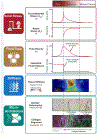The peritumor microenvironment: physics and immunity
- PMID: 37156677
- PMCID: PMC10523902
- DOI: 10.1016/j.trecan.2023.04.004
The peritumor microenvironment: physics and immunity
Abstract
Cancer initiation and progression drastically alter the microenvironment at the interface between healthy and malignant tissue. This site, termed the peritumor, bears unique physical and immune attributes that together further promote tumor progression through interconnected mechanical signaling and immune activity. In this review, we describe the distinct physical features of the peritumoral microenvironment and link their relationship to immune responses. The peritumor is a region rich in biomarkers and therapeutic targets and thus is a key focus for future cancer research as well as clinical outlooks, particularly to understand and overcome novel mechanisms of immunotherapy resistance.
Keywords: immunotherapy; peritumor; physical immunity; physical oncology; tumor microenvironment.
Copyright © 2023 Elsevier Inc. All rights reserved.
Conflict of interest statement
Declaration of interests None are declared by the authors.
Figures



References
Publication types
MeSH terms
Grants and funding
LinkOut - more resources
Full Text Sources
Medical

